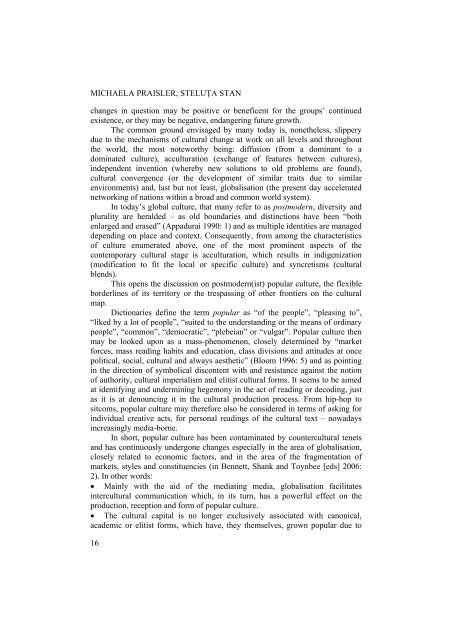culture, subculture and counterculture - Facultatea de Litere
culture, subculture and counterculture - Facultatea de Litere
culture, subculture and counterculture - Facultatea de Litere
You also want an ePaper? Increase the reach of your titles
YUMPU automatically turns print PDFs into web optimized ePapers that Google loves.
MICHAELA PRAISLER, STELUŢA STAN<br />
changes in question may be positive or beneficent for the groups’ continued<br />
existence, or they may be negative, endangering future growth.<br />
The common ground envisaged by many today is, nonetheless, slippery<br />
due to the mechanisms of cultural change at work on all levels <strong>and</strong> throughout<br />
the world, the most noteworthy being: diffusion (from a dominant to a<br />
dominated <strong>culture</strong>), acculturation (exchange of features between <strong>culture</strong>s),<br />
in<strong>de</strong>pen<strong>de</strong>nt invention (whereby new solutions to old problems are found),<br />
cultural convergence (or the <strong>de</strong>velopment of similar traits due to similar<br />
environments) <strong>and</strong>, last but not least, globalisation (the present day accelerated<br />
networking of nations within a broad <strong>and</strong> common world system).<br />
In today’s global <strong>culture</strong>, that many refer to as postmo<strong>de</strong>rn, diversity <strong>and</strong><br />
plurality are heral<strong>de</strong>d – as old boundaries <strong>and</strong> distinctions have been “both<br />
enlarged <strong>and</strong> erased” (Appadurai 1990: 1) <strong>and</strong> as multiple i<strong>de</strong>ntities are managed<br />
<strong>de</strong>pending on place <strong>and</strong> context. Consequently, from among the characteristics<br />
of <strong>culture</strong> enumerated above, one of the most prominent aspects of the<br />
contemporary cultural stage is acculturation, which results in indigenization<br />
(modification to fit the local or specific <strong>culture</strong>) <strong>and</strong> syncretisms (cultural<br />
blends).<br />
This opens the discussion on postmo<strong>de</strong>rn(ist) popular <strong>culture</strong>, the flexible<br />
bor<strong>de</strong>rlines of its territory or the trespassing of other frontiers on the cultural<br />
map.<br />
Dictionaries <strong>de</strong>fine the term popular as “of the people”, “pleasing to”,<br />
“liked by a lot of people”, “suited to the un<strong>de</strong>rst<strong>and</strong>ing or the means of ordinary<br />
people”, “common”, “<strong>de</strong>mocratic”, “plebeian” or “vulgar”. Popular <strong>culture</strong> then<br />
may be looked upon as a mass-phenomenon, closely <strong>de</strong>termined by “market<br />
forces, mass reading habits <strong>and</strong> education, class divisions <strong>and</strong> attitu<strong>de</strong>s at once<br />
political, social, cultural <strong>and</strong> always aesthetic” (Bloom 1996: 5) <strong>and</strong> as pointing<br />
in the direction of symbolical discontent with <strong>and</strong> resistance against the notion<br />
of authority, cultural imperialism <strong>and</strong> elitist cultural forms. It seems to be aimed<br />
at i<strong>de</strong>ntifying <strong>and</strong> un<strong>de</strong>rmining hegemony in the act of reading or <strong>de</strong>coding, just<br />
as it is at <strong>de</strong>nouncing it in the cultural production process. From hip-hop to<br />
sitcoms, popular <strong>culture</strong> may therefore also be consi<strong>de</strong>red in terms of asking for<br />
individual creative acts, for personal readings of the cultural text – nowadays<br />
increasingly media-borne.<br />
In short, popular <strong>culture</strong> has been contaminated by countercultural tenets<br />
<strong>and</strong> has continuously un<strong>de</strong>rgone changes especially in the area of globalisation,<br />
closely related to economic factors, <strong>and</strong> in the area of the fragmentation of<br />
markets, styles <strong>and</strong> constituencies (in Bennett, Shank <strong>and</strong> Toynbee [eds] 2006:<br />
2). In other words:<br />
• Mainly with the aid of the mediating media, globalisation facilitates<br />
intercultural communication which, in its turn, has a powerful effect on the<br />
production, reception <strong>and</strong> form of popular <strong>culture</strong>.<br />
• The cultural capital is no longer exclusively associated with canonical,<br />
aca<strong>de</strong>mic or elitist forms, which have, they themselves, grown popular due to<br />
16












